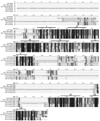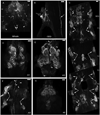Cloning and immunoreactivity of the 5-HT 1Mac and 5-HT 2Mac receptors in the central nervous system of the freshwater prawn Macrobrachium rosenbergii
- PMID: 19184976
- PMCID: PMC2719784
- DOI: 10.1002/cne.21979
Cloning and immunoreactivity of the 5-HT 1Mac and 5-HT 2Mac receptors in the central nervous system of the freshwater prawn Macrobrachium rosenbergii
Abstract
Biogenic amines are implicated in several mental disorders, many of which involve social interactions. Simple model systems, such as crustaceans, are often more amenable than vertebrates for studying mechanisms underlying behaviors. Although various cellular responses of biogenic amines have been characterized in crustaceans, the mechanisms linking these molecules to behavior remain largely unknown. Observed effects of serotonin receptor agonists and antagonists in abdomen posture, escape responses, and fighting have led to the suggestion that biogenic amine receptors may play a role in modulating interactive behaviors. As a first step in understanding this potential role of such receptors, we have cloned and fully sequenced two serotonin receptors, 5-HT(1Mac) and 5-HT(2Mac), from the CNS of the freshwater prawn Macrobrachium rosenbergii and have mapped their CNS immunohistochemical distribution. 5-HT(1Mac) was found primarily on the membranes of subsets of cells in all CNS ganglia, in fibers that traverse all CNS regions, and in the cytoplasm of a small number of cells in the brain and circum- and subesophageal ganglia (SEG), most of which also appear to contain dopamine. The pattern of 5-HT(2Mac) immunoreactivity was found to differ significantly; it was found mostly in the central neuropil area of all ganglia, in glomeruli of the brain's olfactory lobes, and in the cytoplasm of a small number of neurons in the SEG, thoracic, and some abdominal ganglia. The observed differences in terms of localization, distribution within cells, and intensity of immunoreactive staining throughout the prawn's CNS suggest that these receptors are likely to play different roles.
(c) 2009 Wiley-Liss, Inc.
Figures









Similar articles
-
Cloning and distribution of a putative octopamine/tyramine receptor in the central nervous system of the freshwater prawn Macrobrachium rosenbergii.Brain Res. 2010 Aug 12;1348:42-54. doi: 10.1016/j.brainres.2010.06.021. Epub 2010 Jun 15. Brain Res. 2010. PMID: 20558147 Free PMC article.
-
Distribution of dopamine and octopamine in the central nervous system and ovary during the ovarian maturation cycle of the giant freshwater prawn, Macrobrachium rosenbergii.Tissue Cell. 2009 Dec;41(6):430-42. doi: 10.1016/j.tice.2009.05.001. Epub 2009 Jul 24. Tissue Cell. 2009. PMID: 19631953
-
Changes in the levels of serotonin and dopamine in the central nervous system and ovary, and their possible roles in the ovarian development in the giant freshwater prawn, Macrobrachium rosenbergii.Gen Comp Endocrinol. 2008 Sep 15;158(3):250-8. doi: 10.1016/j.ygcen.2008.07.009. Epub 2008 Aug 5. Gen Comp Endocrinol. 2008. PMID: 18713629
-
5-HT2 receptors.Curr Drug Targets CNS Neurol Disord. 2004 Feb;3(1):11-26. doi: 10.2174/1568007043482598. Curr Drug Targets CNS Neurol Disord. 2004. PMID: 14965241 Review.
-
Serotonin receptors in brain revisited.Brain Res. 2016 Aug 15;1645:46-9. doi: 10.1016/j.brainres.2015.12.042. Epub 2015 Dec 29. Brain Res. 2016. PMID: 26740406 Review.
Cited by
-
Serotonergic modulation across sensory modalities.J Neurophysiol. 2020 Jun 1;123(6):2406-2425. doi: 10.1152/jn.00034.2020. Epub 2020 May 13. J Neurophysiol. 2020. PMID: 32401124 Free PMC article. Review.
-
Characterization of a prawn OA/TA receptor in Xenopus oocytes suggests functional selectivity between octopamine and tyramine.PLoS One. 2014 Oct 28;9(10):e111314. doi: 10.1371/journal.pone.0111314. eCollection 2014. PLoS One. 2014. PMID: 25350749 Free PMC article.
-
Dm5-HT2B: Pharmacological Characterization of the Fifth Serotonin Receptor Subtype of Drosophila melanogaster.Front Syst Neurosci. 2017 May 11;11:28. doi: 10.3389/fnsys.2017.00028. eCollection 2017. Front Syst Neurosci. 2017. PMID: 28553207 Free PMC article.
-
Serotonin in Animal Cognition and Behavior.Int J Mol Sci. 2020 Feb 28;21(5):1649. doi: 10.3390/ijms21051649. Int J Mol Sci. 2020. PMID: 32121267 Free PMC article. Review.
-
A characterization of the Manduca sexta serotonin receptors in the context of olfactory neuromodulation.PLoS One. 2013 Jul 29;8(7):e69422. doi: 10.1371/journal.pone.0069422. Print 2013. PLoS One. 2013. PMID: 23922709 Free PMC article.
References
-
- Adams CF, Liley NR, Gorzalka BB. PCPA increases aggression in male firemouth cichlids. Pharmacology. 1996;53(5):328–330. - PubMed
-
- Albert FW, Shchepina O, Winter C, Römpler H, Teupser D, Palme R, Ceglarek U, Kratzsch J, Sohr R, Trut LN, Thiery J, Morgenstern R, Plyusnina IZ, Schöneberg T, Pääbo S. Phenotypic differences in behavior, physiology and neurochemistry between rats selected for tameness and for defensive aggression towards humans. Horm Behav. 2008;53(3):413–421. - PubMed
-
- Barbas D, Zappulla JP, Angers S, Bouvier M. Functional characterization of a novel serotonin receptor (5-HTap2) expressed in the CNS of Aplysia californica. J Neurochem. 2002;80:335–345. - PubMed
Publication types
MeSH terms
Substances
Grants and funding
- R01 NS39103/NS/NINDS NIH HHS/United States
- R24 MH048190/MH/NIMH NIH HHS/United States
- R25 GM061838/GM/NIGMS NIH HHS/United States
- S06GM008224/GM/NIGMS NIH HHS/United States
- R21 RR025699/RR/NCRR NIH HHS/United States
- MH48190/MH/NIMH NIH HHS/United States
- G12 RR003051/RR/NCRR NIH HHS/United States
- S06 GM008224/GM/NIGMS NIH HHS/United States
- G12RR03051/RR/NCRR NIH HHS/United States
- R01 NS039103/NS/NINDS NIH HHS/United States
- G12 MD007600/MD/NIMHD NIH HHS/United States
- SC3 GM084763/GM/NIGMS NIH HHS/United States
- G12 RR003050/RR/NCRR NIH HHS/United States
LinkOut - more resources
Full Text Sources
Research Materials
Miscellaneous

